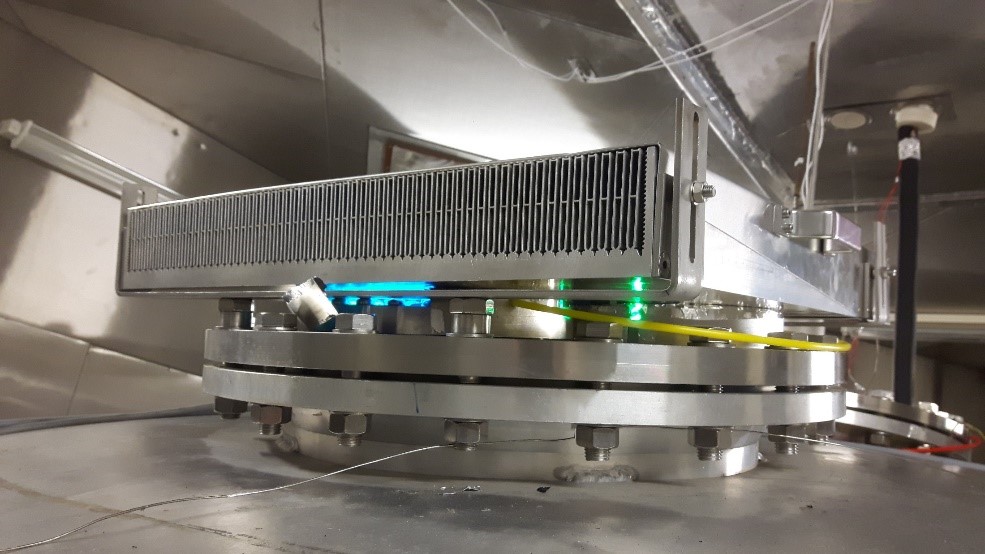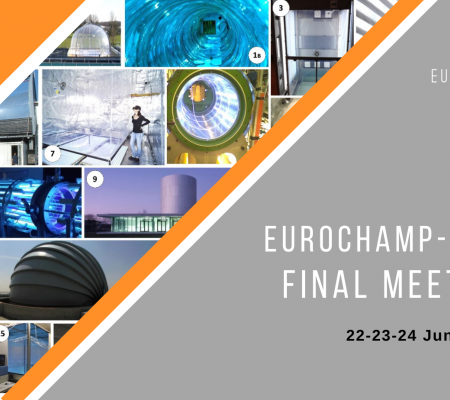| General information | |
| Access mode | Physical access |
| Infrastructure name and acronym | Aerosol Interaction and Dynamics in the Atmosphere (AIDA) |
| Photos |
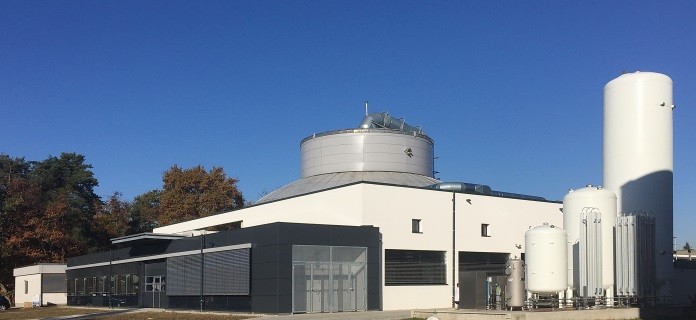  |
| Location |
The AIDA chamber is located about 10 km north of the city of Karlsruhe, Germany, at 49°05'42.9"N 8°25'45.7"E. |
| Website | http://www.imk-aaf.kit.edu/73.php |
| Legal name of organisation operating the infrastructure | Karlsruhe Institute of Technology (KIT) |
| Description of the infrastructure | |
| Brief general description of the infrastructure to which access is offered |
AIDA is a unique experimental facility for investigating the impact of aerosols on climate, weather, and the environment. Aerosol and cloud experiments are performed in the 84.5 m3 AIDA chamber under relevant atmospheric conditions within a wide range of temperature(+50°C to -90°C), pressure (1 to 1000 hPa), and relative humidity (0% to 100%). During cloud simulation experiments, transient water and ice supersaturations are achieved for time periods from minutes up to about 1 hour with peak relative humidity values of more than 200%. Aerosol aging experiments can be performed on time scales up to several days. Thereby, the capabilities to simulate tropospheric and stratospheric conditions and to generate supersaturations and clouds in a large volume are unique in Europe. A 3.7 m3 volume stainless steel chamber for the preparation and characterisation of aerosols at room temperature is connected to the large AIDA chamber. The AIDA facility is equipped with an extensive suite of state of the art instruments, both commercial and custom built. Research areas supported at the ADIA facility include aerosol physics, aerosol chemistry, and aerosol-cloud interactions. Analysis of the AIDA experiments is supported with the AIDA database and the aerosol process model COSIMA. Unique features: - Coverage of a wide temperature, pressure, and humidity range - Generation and control of liquid, mixed-phase and ice clouds - In situ instruments for the characterisation of aerosols & trace gases - Capability to install and simultaneously operate many sampling and in situ instruments from external users. |
| Services currently offered by the infrastructure and its research environment | The AIDA team offers support for planning the chamber use (joint workshops, kick off meetings), for adapting instruments to the chamber, for data acquisition, for remote access to instruments, for data storage and documentation , for flexible experiment planning during measurement campaigns (TNA), and for data analysis. The AIDA facility is also offered and used as a platform to test, intercompare and calibrate atmospheric hygrometers and ice nucleating particle instruments. Administrative support is offered for shipment and customs issues as well as for travel directions and accommodation. Suggestions for new research topics/experiments are welcome and will be discussed with the users to find the appropriate setup for new projects at AIDA. |
| Modalities of access and support offered under EUROCHAMP-2020 | |
| Typical duration of work |
Most campaign have a duration between 1 and 4 weeks. A typical measurement campaign includes a few days of careful preparation of the experiments (e.g. connection of potential external instruments, scientific discussion and scheduling), then 1-3 weeks (5-15 working days) of experiments, followed by 1-2 days for deinstallation and debriefing. Typically, experiments are conducted during working days and day time. The night time is used for automated cleaning and experiment preparation cycles. |
| Community/user type served |
Research groups from atmospheric science community make up the vast majority of the users. To a smaller extend, companies use the facility for testing new and innovative instruments. |
| Scientific and technical support offered | The AIDA team offers support for planning the chamber use (joint workshops, kick off meetings, daily science meetings), for adaptation of instruments to the chamber (electronic or mechanical workshops), for synchronous data acquisition (local network, IT support), for remote access to instruments, for data storage (facility database), and for data analysis. |
| Logistic and administrative support offered | The AIDA team offers support for transport of instruments, customs issues, TNA applications, travel and local accommodation. |
| Person in charge of access provision at the infrastructure |
Dr. Harald Saathoff, harald.saathoff@kit.edu Dr. Ottmar Möhler, ottmar.moehler@kit.edu Usually all leading scientists at the AIDA facility support the trans national access activities. |
| Extended technical description | |
| Physical description | The AIDA chamber consists of an aluminium (ALMg3) cylinder. Volume: 84.5 m3 Diameter: 4.0 m Heigth: 7.5 m Projected horizontal surface area: 12 m2 Surface to volume ratio: 1.2 m-1 Temperature range: 183-323 K Pressure range: 0.01 to 1100 hPa |
| Mechanical description |
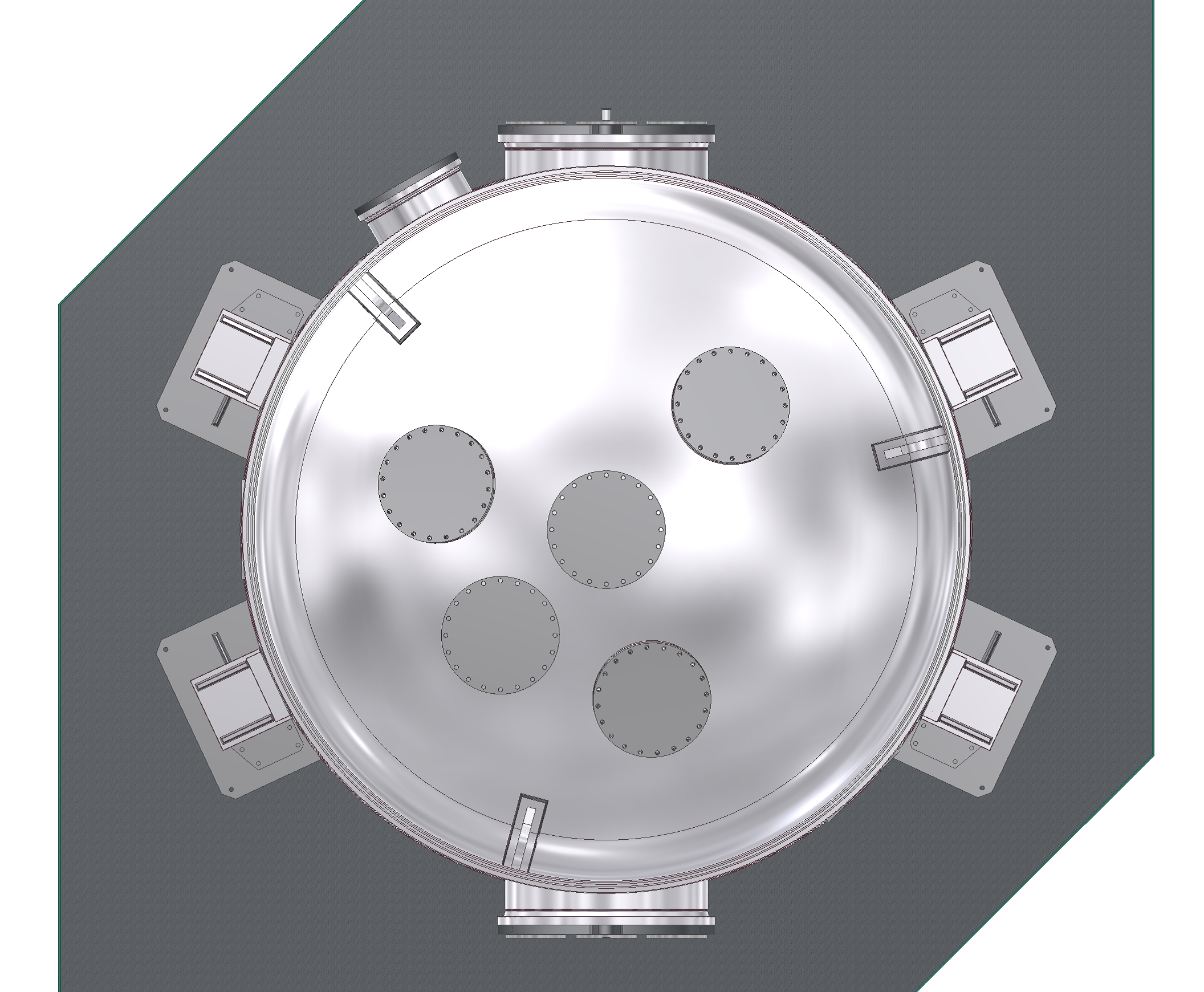 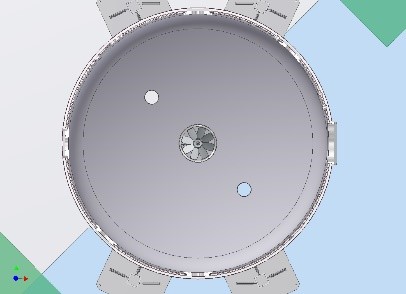   |
| Irradiation system |
The light source in the AIDA aerosol and cloud simulation chamber of KIT, allows to simulate daylight conditions in different intensities and corresponding to different altitudes in the atmosphere and thus facilitating studies on photochemical processes including trace gases, aerosol particles and clouds. A special challenge is not to disturb the excellent temperature homogeneity within the chamber (±0.3 K) and to achieve a spectral photon flux close to solar radiation for chamber temperatures between 183 -298 K and with a variable spectrum. For this purpose a combination of different high power light emitting diodes (LEDs) from different manufacturers is used with nominal emissions between 305 nm and 525 nm. The light source is controlled with a dedicated software allowing for dimming of individual LED types. The actual light spectrum is monitored by a fibre-coupled spectrometer connected to the bottom of the chamber. The different high power light emitting diodes (LEDs) are mounted on aluminum heat sinks (cf. Figure 1) which are placed on nine quartz windows on top of the chamber. An air flow forced through the heat sink is cooling the LEDs. The space between chamber window and LEDs is flushed with pure nitrogen to keep the LEDs dry and to avoid formation of ozone. Figure 2 shows the location of the nine quartz windows of 200 mm diameter on three flanges of 500 mm diameter on top of the AIDA chamber as well as a view inside the chamber with blue LEDs switched on. Due to the relatively wide emission angle of the LEDs a significant amount of the radiation is illuminating the chamber walls.
Figure 1: One of three aluminum heat sinks with different LEDs mounted on top of a 500 mm flange with three 200 mm quartz windows.  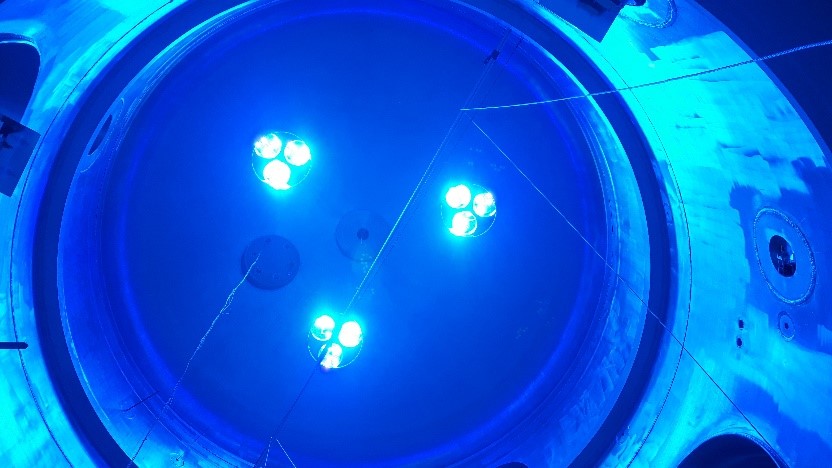 Figure 2 left: View on the top of the AIDA vessel inside its housing (grey area) with 5 flanges of 500 mm diameter of which 3 are used to mount 9 quartz windows of 200 mm diameter (green); right: View inside the chamber from the bottom to the top with LEDs on. |
| Irradiation spectra | Measurements inside the chamber volume with a calibrated spectro radiometer (SR900, Opsytec GmbH) show a relatively strong vertical gradient in irradiation intensities (cf. figure 3) but only relatively small horizontal gradients (not shown here) over the 4 m diameter of the AIDA cylinder (height: 7.5 m).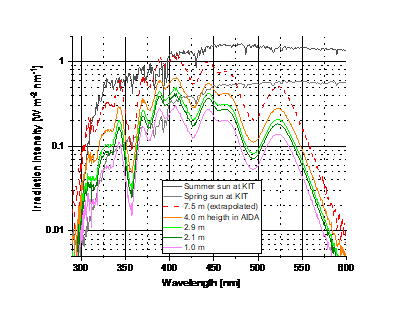 Figure 3: Spectra measured inside the middle of the AIDA chamber at different heights above its bottom (0-7.5 m) compared to a solar spectrum measured for clear sky on April 2nd at 11:15 local time and the maximum possible solar irradiation at KIT in Karlsruhe, Germany. The spectrum at the top of the chamber has intensities between those in the local clear sky atmosphere in summer and spring but the intensity decreases by about on order of magnitude until it reaches the bottom of the chamber. Hence, a significant amount of light intensity seems to be lost to the chamber walls. Furthermore, there are some spectral gaps at 355 and 490 nm compared to the solar spectrum. |
| Photolysis rates j(NO2) |
Photolysis frequencies were measured for NO2 at temperatures between 213 and 296 K. Figure 4 shows an example of such an actinometric experiment at 273 K with initially 39 ppb of NO2 in synthetic air. 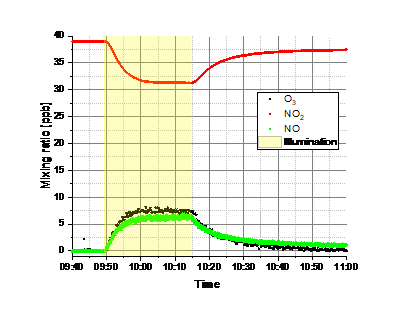 Figure 4: Evolution of mixing ratios of O3, NO2, and NO at 273 K for determination of the photolysis rate of NO2. The NO2 photolysis experiments at temperatures between 213 and 296 K resulted in NO2 photolysis rates between 1.2*10-3 s-1 and 1.8*10-4 s-1 with maximum values observed between 243 and 273 K. These values are a factor of 2-4 lower than typical maximum values observed in the local atmosphere during spring and summer, respectively. |
| Auxiliary mechanism | 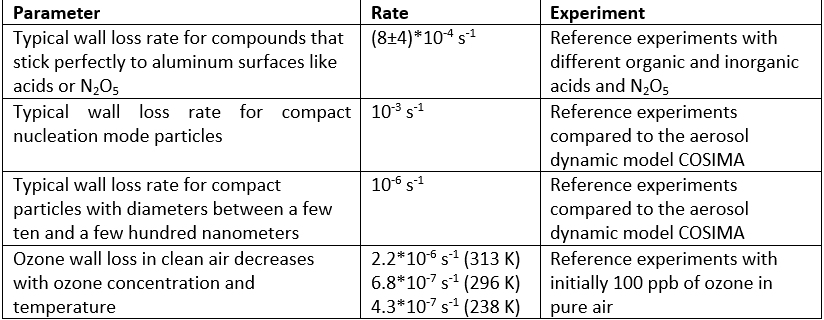 |
| Instrumentation |
The AIDA chamber is equipped with a comprehensive, unique set of sensitive instruments for trace gases, aerosol particles, cloud droplets, ice crystals, and physical parameters. Trace gases are measured in situ by long path absorption (3 White cells with optical paths length up to 300 m) using an FTIR spectrometer (VERTEX 80, Bruker) and a tunable diode laser hygrometer (H2O & HDO). Trace gases are sampled via Teflon and coated steel tubes and measured by various monitors (O3, NO, NO2, SO2, CO, CO2), optical feedback cavity ring down spectroscopy (water isotopologues), as well as mass spectrometers (HR-TOF-CIMS (Iodide ions), Aerodyne; HR-TOF-PTR-MS 4000, Ionicon). Water vapor is measured also by a calibrated reference dew point hygrometer (MBW373). Aerosol particles are characterized online by a high resolution aerosol mass spectrometer (WToF-AMS, Aerodyne, size resolved chemical composition), a chemical ionization mass spectrometer using iodide ions (FIGAERO-HR-TOF-CIMS, Aerodyne, oxidized organic compounds), and a CHARON inlet coupled online to a proton transfer mass spectrometer (CHARON PTR-TOF-MS 4000, Ionicon, volatile particle compounds). Furthermore, different condensation particle counters with different lower cut-off sizes (CPCs, TSI & Palas), different particle sizers covering the size range from 4 nm to 240 µm (SMPS, APS, WELAS OPC) are connected to the chamber. Particle light scattering and depolarization are monitored in situ at a wavelength of 488 nm (SIMONE). Particle optical properties are measured by a single particle soot photometer (SP2), a photoacoustic absorption spectrometer, and a nephelometer (TSI). Physical parameters like pressure and temperatures are permanently monitored. |
| Size dependent aerosol loss/lifetime | The wall loss for compact particles in the AIDA chamber range between about 10-3 s-1 (nucleation mode) to 10-6 s-1 for diameters between a few and a few hundred nanometers, respectively. For example the lifetime for compact accumulation mode particles is in the order or 1-2 days and for aggregate particles like soot it is in the order of 10 days.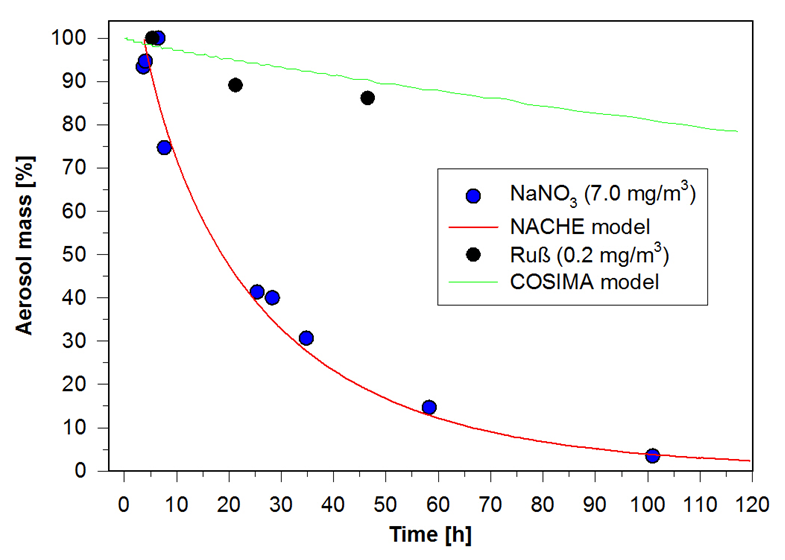 |
| Description paper |
A review of optical measurements at the aerosol and cloud chamber AIDA, Wagner, R., Linke, C., Naumann, K. H., Schnaiter, M., Vragel, M., Gangl, M. and Horvath, H., Journal of Quantitative Spectroscopy & Radiative Transfer 110 (11), 930-949 (2009) Chamber Simulations of Cloud Chemistry: The AIDA Chamber, Wagner, Robert and Bunz, Helmut and Linke, Claudia and Möhler, Ottmar and Naumann, Karl-Heinz and Saathoff, Harald and Schnaiter, Martin and Schurath, Ulrich, Proceedings of the NATO Advanced Research Workshop No. 980164 “Environmental Simulation Chambers: Application to Atmospheric Chemical Processes", Barnes, I. and Rudzinski, K. (Eds.), Springer (2006) |



